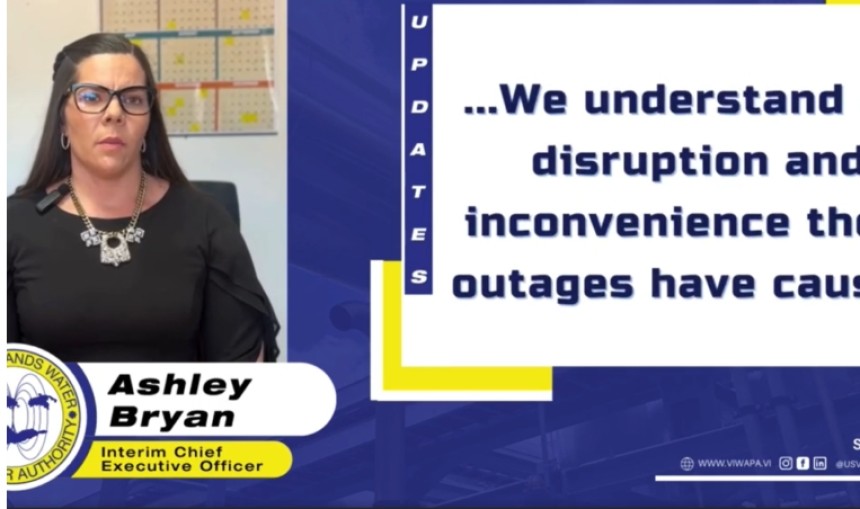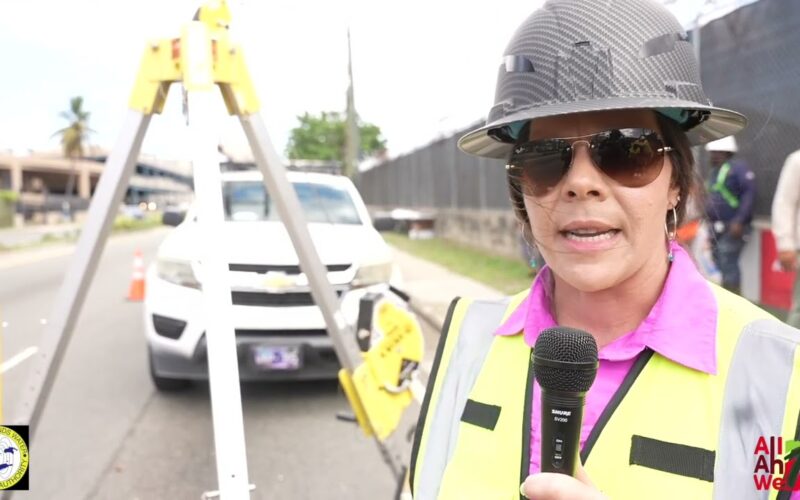CHARLOTTE AMALIE — Interim Electric Chief Operating Officer for the Virgin Islands Water and Power Authority, Ashley Bryan, has resigned effective November 29, and she reflected on her decade with the utility during Thursday’s board meeting.
“It’s been a long 10 years but a very, very rewarding 10 years,” Bryan said.
She returned home to the Virgin Islands and applied to work for WAPA “as a young engineer,” and jumped into work on energy projects like the Donoe Solar Farm with mentor Cordell Jacobs. She added, “he’s the reason I know as much as I know about a lot of the intricacies of WAPA.”
Bryan thanked Jacobs, “for letting me shadow him and learn from him, and then all the other mentors and young engineers,” like Chavante Marsh, and all of the WAPA staff.
Bryan did not say what she intends to do next, but said she will remain in contact and is “willing and able to assist in any way I possibly can.”

Ashley Bryan for WAPA on Facebook
Bryan served as interim WAPA CEO following the resignation of former CEO Andrew Smith in June, after he spent only two years in the role.
Her brief time in leadership was widely lauded by WAPA customers who were impressed by Bryan’s transparency and candor, and many expressed disappointment when she was passed over for the permanent position.
Instead, the WAPA board hired Gov. Albert Bryan Jr.’s former Chief of Staff, Karl Knight in late July.
During Thursday’s meeting, Knight said he appreciated Bryan’s willingness to ”fill the voids that have been created over the last several years.”
In addition, “I know she’s had an impact on the young engineers in the company, they’ve told me that directly themselves,” Knight said.
“We wish her well on her future endeavors,” and “whatever she moves on to do, she will be keeping an eye on what we’re doing here and willing to lend her advice and wisdom when the time comes, but I just want to thank her and congratulate her on her tenure here with the Water and Power Authority and wish her well,” Knight said.
Board members also thanked Bryan for her service, and praised her professionalism and expertise.
In response to questions from The Daily News, WAPA spokeswoman Shanell Petersen said Thursday that Bryan’s replacement has not yet been announced.
At around 10 a.m. Thursday, while the WAPA board meeting was taking place, a problem with underground transmission lines on the waterfront caused a major power failure, leaving thousands of customers without service on St. Thomas and St. John.
Various feeders were affected at different times, and more than 13,000 customers were without power as of 3 p.m.
At one point, WAPA issued a statement estimating that repairs would conclude at around 5 p.m., but nearly 4,000 customers remained without power as of 7 p.m.
WAPA published a schedule of rotating feeder outages that extended to 11 p.m., which affected feeders 7C, 9E, 9C, 7E, 9B, 7B, 8B, and 10B.
During the meeting, board members voted to approve a no-cost time extension for a contract with NRC, which has been working with WAPA for decades, and assisted in the cleanup of a fuel spill at the Harley Plant last year.
Environmental Manager Maxwell George said the company does “cleanups, they assist us on quite a number of different occasions in the past,” including the most recent oil spill, and provide personnel, equipment, training, and documentation review related to response remediation.
Of the $1.56 million allocated in the contract, George said they’ve spent approximately $700,000, and they expect to expend another $30,000 by the end of the year, “to include the retainer and the trainings in both districts.”
Board members approved the extension through October 30, 2026.
Board members voted to approve a three-year, $27 million contract with Wartsila for operation and maintenance of four new generators and battery energy storage at the Harley Plant.
The units are expected to be in service by the end of the year, but WAPA attorney Dionne Sinclair said the full contract has not yet been negotiated and “it will take some time to get the specifics.”
Board members also met in a lengthy executive session, after which they voted to authorize Knight to enter into negotiations with Aggreko to extend the existing lease for generators at the St. Croix plant for two years, in an amount not to exceed $18 million.
During his executive director’s report, Knight provided an update on the status of new meters, which are urgently needed to help end the crisis of estimated billing due to the failing Automated Metering Infrastructure, which is causing major headaches for customers.
Knight said 1,100 new manual meters have arrived but “they are all spoken for already,” and a second order of 2,500 is “like a 12-week ship time, so that’s a lot longer than I had hoped for. But we’ll get to work on installing this 1,100 meters, and if there’s an opportunity to get shipment in before the 12-week schedule, we’ll certainly do that.”
The plan is to distribute 500 meters on St. Thomas, 500 on St. Croix, and 100 on St. John, and “each island needs in excess of what we can supply right now, so that will be the initial distribution.”
Board member Kyle Fleming asked about the status of efforts to put traditionally above-ground power lines underground, given the fact that recent flooding has caused failures across the territory in areas with existing — and aging — underground lines.
“Undergrounding is heralded as being our best option for resiliency,” Fleming said, but they’re seeing situations where undergrounding “has made issues more difficult for us to resolve.”
“You’re absolutely correct, we are investing a lot in undergrounding,” in an effort to protect the system against wind damage, Fleming said.
“In trying to mitigate that risk, we exposed ourselves to other points of failure, in this case, heavy rains and flooding have been a challenge,” Knight said.
There were issues at the Richmond substation after Tropical Storm Ernesto, and “we’re recognizing that flood events and how stormwater is managed is very critical to our ability to keep the underground system functioning,” he said.
He apologized to the downtown Christiansted community for disruptions related to flooded underground transformers, and said the manholes “were bubbling, the lids were bubbling.”
Knight said they’re learning that “these are not maintenance-free systems,” and Bryan said Thursday’s outage was due to failure of the underground Feeder 13 on the waterfront.
“Where we had the incident with Feeder 13, you actually have two transmission lines that are in the same duct bank, which is Feeder 11 and Feeder 13, and then you have a water main that was installed before I was even a thought, directly parallel to that duct bank. You wouldn’t do that in today’s type of construction,” Bryan said.
“So the challenges that we were having is that the infrastructure is old, there’s not a lot of sectionalizing points existing on the old infrastructure that would allow you to do more troubleshooting,” she said.
Previously, WAPA crews would “work hot” and repair a damaged line while another line was energized in the same duct bank, but “you can’t do that anymore, because the hazard is so great in that manhole that if a failure happens, the person that’s working in that manhole is essentially dead,” Bryan said, so more customers must be taken offline to safely work in manholes, than if the lines had been constructed in separate areas.
Knight says the underground system worked well during Ernesto, “so the potential is there, there are benefits, and we have realized those benefits. We need to mitigate against some of the risks.”
Board member Hubert Turnbull also asked about the transformer supply, as “I’ve heard that we have the wrong transformers, the wrong size.”
“There was a large order of 277-480 volt transformers, pole-mounted, that came in during the hurricane recovery,” Bryan said.
“We have a large surplus on St. Thomas and St. Croix. They’re not a common voltage class, the majority of our customers are not large power,” Bryan said. “So we can’t really use the transformers.”
They’ve reached out to vendors to see if they can sell them, “the problem is that they were purchased with FEMA funds, so we have to be careful about how you go through that,” and “essentially, if we sell them we would have to reimburse FEMA for that as a disposal,” Bryan said.
Vendors have also reported back, “that it’s not a marketable voltage level for transformers, so you’re basically only going to get like $2 per kVA, if that, so it’ll cost you more to ship them away, than it would for you to try to do something,” Bryan said.
In response to questions Thursday, Petersen said she doesn’t have information about how many transformers remain unused, and the dollar value paid for that equipment, but would work on providing it.
They’re also trying to swap out the transformers, “the problem with the industry right now is that the transformer guidelines under the DOE were changed some time around COVID,” and now need to be made of more efficient steel, which is becoming harder to find in the market.
“So, you’re improving efficiency by like 2% but the supply chain has suffered because of it,” she said.
WAPA has had “several large orders of transformers” in for quite some time, and they “still don’t have a lead time on those orders that have been pending for several years,” she added.
By SUZANNE CARLSON/Virgin Islands Daily News


